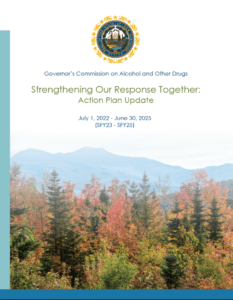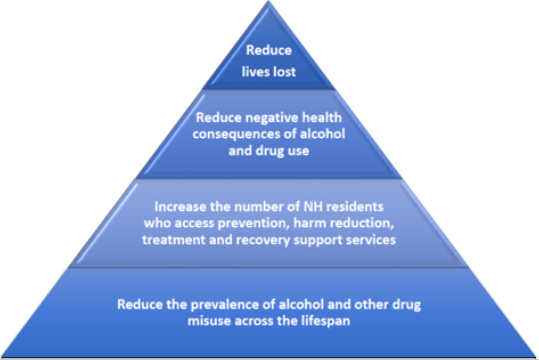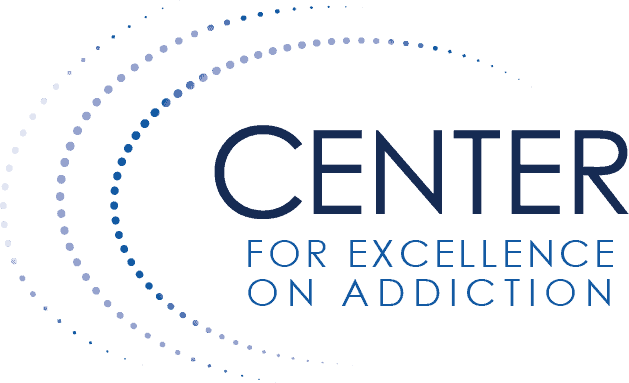NH Governor’s Commission Action Plan Dashboard
Our Plan
 Strengthening Our Response Together is the Action Plan of NH Governor’s Commission on Addiction, Treatment, and Prevention to comprehensively address our state’s addiction crisis. This updated five-year strategic plan serves as a blueprint for shared efforts with a focus on alignment, coordination, innovation and accountability.
Strengthening Our Response Together is the Action Plan of NH Governor’s Commission on Addiction, Treatment, and Prevention to comprehensively address our state’s addiction crisis. This updated five-year strategic plan serves as a blueprint for shared efforts with a focus on alignment, coordination, innovation and accountability.
Our Goal
The Commission’s goal is to reduce the misuse of alcohol and other drugs across the lifespan through the implementation of effective programs, practices and policies.
 This Action Plan dashboard tracks progress on four overarching objectives for accomplishing this goal over the period July 2022 to June 2027. The figure summarizes these four objectives from reducing the prevalence of alcohol and other drug misuse to reducing lives lost from substance misuse. Measures selected for this dashboard prioritize data from existing sources that are consistently reliable, accessible and available at a statewide level. The Commission is also working to incorporate measures that reflect a continuum of care, extending beyond crisis intervention or treatment outcomes to encompass a comprehensive, systemic perspective including prevention efforts, early intervention strategies, harm reduction initiatives, and long-term recovery support
This Action Plan dashboard tracks progress on four overarching objectives for accomplishing this goal over the period July 2022 to June 2027. The figure summarizes these four objectives from reducing the prevalence of alcohol and other drug misuse to reducing lives lost from substance misuse. Measures selected for this dashboard prioritize data from existing sources that are consistently reliable, accessible and available at a statewide level. The Commission is also working to incorporate measures that reflect a continuum of care, extending beyond crisis intervention or treatment outcomes to encompass a comprehensive, systemic perspective including prevention efforts, early intervention strategies, harm reduction initiatives, and long-term recovery support
The epidemic of addiction and drug overdose is a public health crisis touching every community in NH. Use of illicit opioids, particularly fentanyl, in combination with other substances, account for the vast majority of overdoses and deaths caused by overdose. NH has implemented multiple strategies to address this crisis including distribution of the opioid overdose reversal medication naloxone widely to people who may use drugs, and their friends, and family members. During the COVID-19 pandemic (2020-2022), drug overdose deaths increased in New Hampshire by about 17%. More recently a trend toward fewer drug overdose deaths has resumed with substantial progress occurring in 2024 when the fewest number of drug overdose deaths were reported since 2013.
In addition to the objective to reduce drug overdose deaths, the work of the Commission includes objectives for reducing deaths associated with acute and chronic alcohol misuse. In 2023, 54 deaths due to alcohol-related overdose were recorded among NH residents and 228 deaths due to chronic liver disease and cirrhosis, which are conditions that can be associated with chronic alcohol misuse.
Our objective targets for 2027 include:
-
- 1.1: Decrease the number of drug overdose deaths by 15%.
- 1.2a: Decrease the rate of alcohol-related overdose deaths by 15%.
- 1.2b: Decrease the rate of chronic liver disease or cirrhosis deaths by 15%.
Data sources: NH Office of Chief Medical Examiner for drug overdose deaths. NH DHHS Data Portal for alcohol-related deaths.
Trends in Emergency Medical Service (EMS) calls can serve as a useful indicator of the negative health consequences of alcohol and drug use because EMS often responds to acute events directly resulting from substance use. This includes overdoses, injuries, and medical emergencies exacerbated by substance use.
Our objective targets for 2027 include:
- 2.1: Decrease the number of EMS cases resulting from drug overdose / misuse of medications by 15%.
- 2.2: Decrease the number of EMS cases resulting from alcohol misuse and effects by 10%.
Data source: NH Department of Safety, Division of Fire Standards and Training and Emergency Medical Services.
Significant progress has been made to increase access to substance use services and supports in NH including:
- The Doorway system, providing access to screening, assessment, and referral to services, is available throughout the state;
- Availability of telehealth has been expanded substantially;
- Access to and utilization of Medication for Addiction Treatment (MAT) has increased significantly throughout NH;
- Recovery Community Organizations have expanded Recovery Centers throughout NH;
- Recovery Friendly Workplace has continued and expanded; and
- Substance use treatment availability has expanded in multiple settings.
Our objective targets for 2027 include:
- 3.1: Increase the percentage of individuals ages 13+ who initiate substance use treatment within 14 days of a new SUD diagnosis by 10%.
- 3.2: Increase the number of individuals engaged by Recovery Community Organizations in Peer Recovery Support Services by 10%.
- 3.3: Decrease the number of NH residents ages 12+ who report needing, but not receiving treatment by 10%.
Important Note – The NSDUH made several important revisions to the survey questionnaire and methodology over the period 2020 to 2022. In 2022, NSDUH defined substance use treatment more broadly to include treatment received in various settings (inpatient, outpatient, telehealth, correctional facilities) and the receipt of medication-assisted treatment (MAT) for alcohol or opioid use. Starting in 2021, the NSDUH also transitioned from an in-person only survey administration to a multi-mode approach (both in-person and web modes). Lastly, it is likely that data collection and results were impacted during the COVID-19 pandemic.
Data sources: NH DHHS, Medicaid Quality Program for initiation of substance use disorder treatment. NH DHHS Data Portal for participation in recovery support services. National Survey on Drug Use and Health for needing but not receiving SUD treatment.
Reduction of alcohol and other drug misuse and consequences on the health and well-being of individuals, families, and communities requires comprehensive, effective prevention of the initiation of misuse and intervention with problematic use across the lifespan.
Our objective targets for 2027 include:
- 4.1: Decrease the prevalence of NH residents ages 12+ who report current binge alcohol use by 5%.
- 4.2: Decrease the prevalence of NH residents ages 12+ who report recent illicit drug use other than marijuana by 0.5%.
- 4.3: Increase the prevalence of high school students who most of the time or always get the kind of help they need among students who report having felt sad, empty, hopeless, angry, or anxious by 5%.
Data source: National Survey on Drug Use and Health for substance use prevalence statistics. NH DHHS Data Portal for Youth Risk Behavior Survey statistics.
Publicly Available NH Data related to Alcohol and Other Drugs
This dashboard is intended to provide an overview of key measures of substance misuse prevention, intervention, treatment, and recovery in New Hampshire. Additional data is available through the NH Department of Health and Human Services Data Portal and NH Medicaid Quality Behavioral Health Care metrics, the NH Department of Safety Drug Monitoring Initiative, NH Department of Education Youth Risk Behavior Survey Results, and the US Center for Disease Control, Overdose Data to Action Dashboard.
For a list of publicly available data sources in New Hampshire, download the Data Inventory. See the Data Task Force page for more information.
